Semi Precious jewellery business ideas
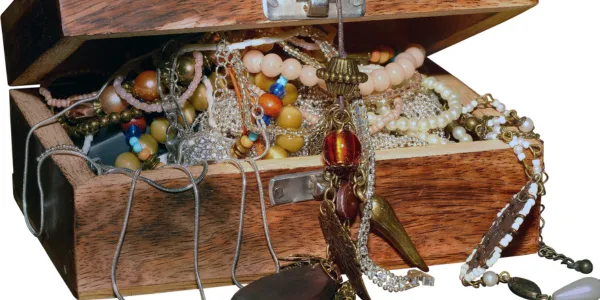
Looking for jewellery business ideas? You’ve come to the right place! Here, you’ll find an exciting semi-precious jewellery business idea that can help you turn your passion into a thriving enterprise.
Semi-precious stones are a great choice for jewelry makers who want to create unique, high-quality pieces that stand out from the crowd. Whether you’re interested in designing and creating your own semi-precious jewelry or curating a collection of stunning pieces from around the world, there’s a wealth of opportunity in the semi-precious jewelry market.
In this search of jewellery business ideas, you’ll discover how to source high-quality semi-precious stones, how to design and create stunning jewelry that showcases their beauty, and how to market and sell your creations effectively. From classic designs to contemporary styles, there are endless possibilities for entrepreneurs in the semi-precious jewelry industry. So why wait? Start exploring today and discover your next big business idea!

What is semi-precious jewelry?
Semi-precious jewelry refers to pieces of jewelry made with gemstones that are not considered precious stones such as diamonds, rubies, sapphires, and emeralds. These gemstones include a wide variety of other natural and synthetic stones such as amethyst, turquoise, opal, and topaz, among others. Semi-precious stones are popular among consumers because they are more affordable than precious stones, yet still offer unique and beautiful designs. This makes semi-precious jewelry an excellent option for entrepreneurs looking for jewellery business ideas that cater to a wider range of consumers.
Why Semi-Precious Jewelry Manufacturing is a Great Business Idea?
Semi-precious jewelry manufacturing business is a great startup idea for a number of reasons. Here are a few key reasons why:
High Demand: There is a growing demand for semi-precious jewelry in the market due to its affordability and versatility. Unlike precious jewelry made of gold and diamonds, semi-precious jewelry is more accessible to a wider range of consumers. This makes it a popular choice for everyday wear, as well as for special occasions.
Low Cost of Production: Semi-precious jewelry manufacturing can be done at a relatively low cost, especially when compared to precious jewelry. This makes it an attractive option for entrepreneurs who are just starting out and don’t have a lot of capital to invest. With the right tools and materials, it’s possible to create high-quality, beautiful pieces of jewelry that are both affordable and profitable.
Unique Design Possibilities: Semi-precious stones come in a wide variety of colors, shapes, and sizes. This makes it possible to create unique and distinctive designs that stand out in the market. By combining different stones and metals, it’s possible to create pieces that are both beautiful and one-of-a-kind.
Sustainable and Ethical: In recent years, there has been a growing interest in sustainable and ethical manufacturing practices. Many consumers are looking for products that are made with eco-friendly materials and produced in a way that respects human rights and fair labor practices. By focusing on sustainable and ethical practices, semi-precious jewelry manufacturers can appeal to these consumers and set themselves apart from competitors.
Market Potential: The market for semi-precious jewelry is vast and growing. With the right marketing and branding strategies, it’s possible to tap into this market and build a successful business. By identifying your target audience and developing a unique brand identity, you can establish a loyal customer base and increase your profits over time.
Overall, semi-precious jewelry manufacturing is a great jewellery business idea for entrepreneurs who are looking for a profitable and sustainable business opportunity. By focusing on quality, design, and sustainability, it’s possible to create a successful and profitable jewelry business that stands out in the market. With a wide range of semi-precious stones to choose from, there are endless possibilities for entrepreneurs to create unique and eye-catching jewelry designs that appeal to a broad audience.

13 Steps to a Successful Jewelry Business
- Validate your business idea by conducting research and consulting with industry experts.
- Hire a consultant or conduct market research to identify your target market, competition, and market trends.
- Develop a detailed business plan that includes production plans, marketing strategies, financial projections, and funding requirements.
- Choose a business structure and register your business with the appropriate government agencies.
- Obtain necessary permits and licenses for operating a jewelry manufacturing business.
- Secure funding from investors or financial institutions to finance your startup costs.
- Identify and source high-quality, sustainable materials for manufacturing your jewelry.
- Purchase equipment and hire skilled artisans to produce your jewelry.
- Develop a brand identity and create a website and social media presence to showcase your products and build your brand.
- Establish partnerships with suppliers and distributors to ensure a steady supply chain.
- Develop a pricing strategy that covers production costs and generates a profit.
- Implement sustainable business practices, such as using eco-friendly materials and reducing waste.
- Monitor and evaluate your business performance regularly and adjust your strategies accordingly.
By following these detailed steps, you can increase the likelihood of success for your jewellery business ideas in semi-precious jewelry manufacturing and brand building. With a solid plan in place, a focus on quality and sustainability, and a commitment to creating unique and eye-catching designs, you can establish a successful and profitable jewelry business that stands out in the market.
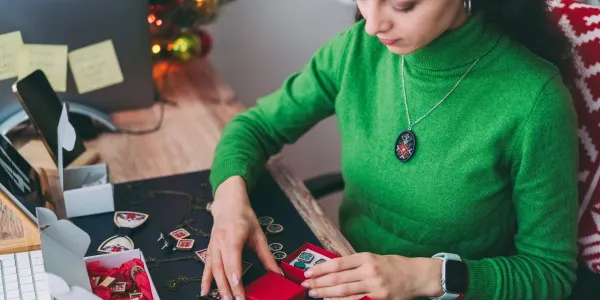
Developing a Business Plan: The Foundation for a Successful Jewelry Business
Developing a business plan is essential to make the jewellery business ideas a reality. A well-crafted business plan serves as the foundation for your jewelry business and outlines your goals, strategies, and tactics. Here are some key steps to developing a business plan for your jewelry business that will help you to establish a solid foundation for your business, build a clear roadmap to success, and attract potential investors or partners.
Executive Summary: The executive summary is a brief overview of your business plan, highlighting key goals and objectives. It should provide a snapshot of your business and include a description of your target market, products, and services.
Company Description: This section provides a more detailed overview of your business, including your mission statement, legal structure, and history.
Market Analysis: The market analysis section should detail your target market and competitors. This includes information on the size and growth of the market, customer demographics, and the competitive landscape.
Products and Services: This section should describe your product offerings and services in detail, including pricing, materials used, and unique features.
Marketing and Sales: The marketing and sales section should outline your strategies for reaching your target market, including advertising, promotions, and sales channels.
Financial Projections: This section should include financial projections for your business, including income statements, balance sheets, and cash flow statements.
Management and Organization: This section should detail the structure of your business and the roles and responsibilities of key personnel.
Implementation Plan: The implementation plan outlines the specific steps you will take to execute your business plan, including timelines and milestones.
By developing a comprehensive business plan, you can set yourself up for success and ensure that your business is built on a solid foundation. A well-crafted business plan can help you secure funding, make informed decisions, and navigate the challenges of building a successful jewelry business.
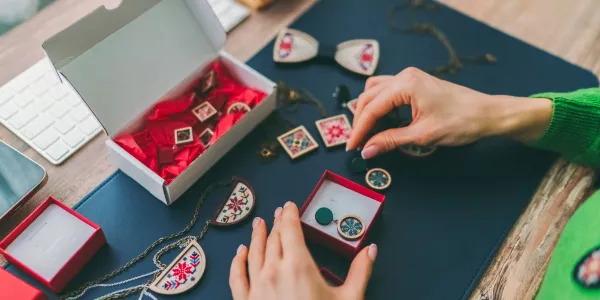
Identifying Your Target Market: Key to a Successful Jewelry Business
Identifying your target market is a crucial step to building successful jewellery business ideas. Without a clear understanding of who your target customers are, it can be difficult to create products that meet their needs and preferences. Here are some key steps to identifying your target market for your jewelry business that will help you to develop a better understanding of your customers, create products that resonate with them, and establish a strong brand identity that appeals to your target market.
Conduct Market Research: Conducting market research is a crucial step to understanding your target market. This can include surveying potential customers, analyzing market trends, and studying your competition. By gathering this information, you can identify key trends, preferences, and needs within the market.
Define Your Brand Identity: Your brand identity should be shaped by your target market. This includes factors such as your brand message, visual design, and product offerings. By developing a clear brand identity that resonates with your target market, you can establish a strong connection with your customers and differentiate yourself from competitors.
Identify Your Ideal Customer: Once you have a clear understanding of the market and your brand identity, you can start to identify your ideal customer. This includes factors such as demographics, interests, and buying behavior. By understanding your ideal customer, you can create products that meet their needs and preferences.
Develop Product Offerings: Based on your market research and target customer analysis, you can start to develop product offerings that meet the needs of your target market. This can include creating designs that appeal to specific demographics, offering products at different price points, and focusing on specific materials and styles.
Test and Refine: Once you have developed your product offerings, it’s important to test them with your target market and gather feedback. This can help you refine your product offerings and ensure that they are meeting the needs and preferences of your target customers.
By following these steps and staying focused on your target market, you can build a successful jewelry business that meets the needs of your customers and stands out in the market. With a clear understanding of your target market, you can create products that resonate with your customers, establish a strong brand identity, and grow your business over time.
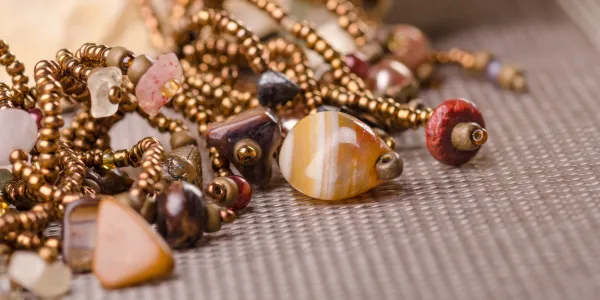
Starting Your Jewelry Business on a Budget: Investment Requirements
The investment required to start jewellery business ideas in semi-precious jewelry business in India can vary depending on several factors, such as the scale of production, the types of materials used, and the marketing strategy employed. Here is an approximate breakdown of the investment required to start this business on a small scale in the Indian market, which will help you to estimate the costs involved and plan your budget accordingly.
Materials and equipment: The cost of materials and equipment is one of the largest expenses in starting a jewelry business. The cost of semi-precious stones, metals, and tools can vary depending on the quality and quantity required. For a small-scale operation, you can expect to spend between Rs. 50,000 to Rs. 1,50,000 on materials and equipment.
Manufacturing and production: The cost of manufacturing and production can vary depending on the complexity of the designs and the size of the production run. For a small-scale operation, you can expect to spend between Rs. 50,000 to Rs. 1,00,000 on manufacturing and production costs.
Marketing and advertising: Marketing and advertising are essential for building brand awareness and attracting customers. The cost of marketing and advertising can vary depending on the strategies employed. For a small-scale operation, you can expect to spend between Rs. 10,000 to Rs. 50,000 on marketing and advertising costs.
Packaging and shipping: The cost of packaging and shipping can vary depending on the size and weight of the products and the shipping distance. For a small-scale operation, you can expect to spend between Rs. 5,000 to Rs. 20,000 on packaging and shipping costs.
Business registration and licenses: To legally operate a business in India, you need to register your business and obtain the necessary licenses. The cost of business registration and licenses can vary depending on the type of business entity and the state in which you operate. For a small-scale operation, you can expect to spend between Rs. 5,000 to Rs. 15,000 on business registration and license costs.
Based on these estimates, the total investment required to execute the jewellery business ideas in a small-scale semi-precious jewelry category in India can range from Rs. 1,20,000 to Rs. 3,35,000. However, these estimates are approximate and can vary depending on several factors specific to your business. It is essential to conduct thorough research and create a detailed business plan to determine the exact investment required to start your semi-precious jewelry business, which will help you to create a realistic budget and secure the necessary funding to launch your business.
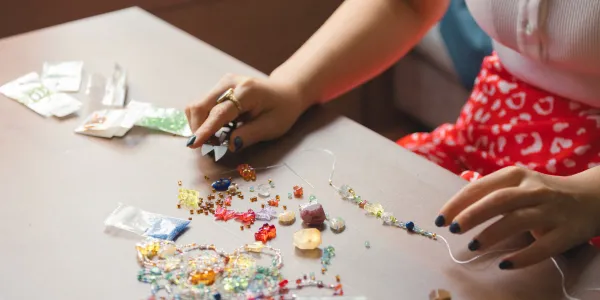
A Sample Project report for Investors and Banks
Project Report: Semi-Precious Jewelry Manufacturing and Brand Building
Introduction: We are a start-up company planning to manufacture semi-precious jewelry and build a brand in the Indian market. Our mission is to create high-quality, unique, and sustainable jewelry that appeals to customers who value ethical production and socially responsible business practices. This project report outlines our business plan, including our marketing strategy, production plan, financial projections, and funding requirements.
Market Analysis: The Indian jewelry industry is rapidly growing, with an estimated market size of over Rs. 5 lakh crore in 2021. The demand for jewelry is driven by factors such as cultural traditions, fashion trends, and personal preferences. The semi-precious jewelry segment is growing in popularity, with customers seeking affordable and unique pieces that incorporate a variety of gemstones and materials. We plan to capitalize on this trend by offering high-quality, sustainable, and affordable semi-precious jewelry.
Production Plan: Our manufacturing process will be focused on ethical production practices and the use of sustainable materials. We will source our semi-precious stones from responsible suppliers who prioritize environmental and social sustainability. Our manufacturing process will be based on traditional jewelry-making techniques, combined with modern technology and equipment. We will initially operate on a small scale, producing 50-100 pieces of jewelry per month.
Marketing Strategy: Our marketing strategy will focus on building brand awareness through social media platforms, online marketplaces, and local exhibitions. We will create engaging content that showcases our jewelry designs and highlights our commitment to sustainable production. We will also partner with influencers and fashion bloggers to increase our reach and build brand recognition.
Financial Projections: We project revenue growth of 30% in the first year of operations, with revenue increasing to Rs. 40 lakhs by the end of the third year. Our net profit margin is expected to be 20%, with a break-even point of 18 months. Our initial investment requirement is Rs. 3 lakhs, which includes the cost of materials, equipment, marketing, and business registration. We plan to finance this investment through a combination of personal savings and external funding.
Funding Requirements: We are seeking funding of Rs. 7 lakhs to expand our production capacity, increase our marketing reach, and invest in sustainable business practices. The funding will be used to purchase additional equipment and materials, hire marketing and production staff, and invest in sustainable technology and practices. We plan to repay the funding through a combination of equity and revenue-sharing agreements.
Conclusion: Our goal is to create a sustainable and socially responsible business that offers high-quality, unique, and affordable semi-precious jewelry to customers in the Indian market. With our focus on ethical production practices, sustainable materials, and innovative design, we believe that we can build a successful brand and contribute to a more sustainable future. We are seeking funding from investors and financial institutions who share our values and vision.
Sustainable Jewelry Manufacturing: A Growing Trend in the Industry
Among the different jewellery business ideas, the sustainable jewelry manufacturing is becoming a growing trend in the industry as consumers become more aware of the environmental and ethical impact of their purchases. The jewelry industry has traditionally been associated with harmful mining practices, unethical labor practices, and environmental degradation. However, sustainable jewelry manufacturing aims to address these issues by using eco-friendly materials, reducing waste, and ensuring ethical labor practices.
One of the main ways in which sustainable jewelry manufacturing is achieved is through the use of recycled metals and gemstones. These materials are obtained from recycled jewelry, electronics, and other sources. By using recycled materials, manufacturers can reduce the demand for new mining and extraction practices, which can be harmful to the environment and surrounding communities.
In addition to using recycled materials, sustainable jewelry manufacturing also involves reducing waste through eco-friendly production practices. This includes using energy-efficient equipment, minimizing the use of chemicals, and recycling any waste produced during the manufacturing process. Manufacturers can also reduce waste by using 3D printing technology to produce jewelry pieces, which eliminates the need for excess materials.
Ethical labor practices are also a key component of sustainable jewelry manufacturing. This involves ensuring that workers are paid fair wages and that their working conditions are safe and healthy. Manufacturers can achieve this by working with suppliers who follow ethical labor practices and by conducting regular audits to ensure compliance.
Sustainable jewelry manufacturing is not only beneficial for the environment and communities but also for businesses. Consumers are becoming increasingly aware of sustainability issues and are more likely to support brands that prioritize sustainable practices. By adopting sustainable jewelry manufacturing practices, businesses can differentiate themselves from competitors, build customer loyalty, and increase their overall brand value.
Overall, sustainable jewelry manufacturing is a growing trend in the industry that is gaining popularity among consumers and businesses alike. Among the different jewellery business ideas, by using eco-friendly materials, reducing waste, and ensuring ethical labor practices, manufacturers can create high-quality jewelry that is not only beautiful but also sustainable.
Importance of building a brand & marketing in the jewelry industry.
Building a brand in the jewelry industry is essential because it helps create brand recognition, trust, and loyalty among customers. It also sets your products apart from other competitors and enables you to charge a premium for your products. To build a successful brand in the jewelry industry, it is essential to have a unique style and vision, high-quality products, and excellent customer service.
Research and development are crucial to the success of any jewelry manufacturing business. The first step is to find inspiration for designs. This can be done by attending trade shows, browsing online marketplaces, and looking at current fashion trends. Once you have an idea, the next step is to source materials. When choosing suppliers, it is important to prioritize quality over cost. You may also consider purchasing materials directly from mines to ensure authenticity and reduce costs.
After acquiring the necessary materials, it is essential to create prototypes. Prototyping helps to identify any flaws in the design, and refine the product to meet customer needs. You may choose to use computer-aided design (CAD) software or hand-drawn sketches to create prototypes. The next step is to test the quality of the products. You can do this by sending samples to a third-party lab for testing or conducting in-house testing to ensure that the product meets industry standards.
Marketing is a crucial aspect of any business, and the jewelry industry is no exception. In today’s highly competitive market, it’s essential to have a strong marketing strategy to attract customers and build a brand that stands out in the industry.
One of the first steps in marketing your jewelry business is to identify your target audience. Understanding your target market’s demographics, interests, and buying habits can help you tailor your marketing efforts to reach them effectively. Once you have identified your target audience, you can develop a marketing plan that includes various tactics such as social media advertising, influencer marketing, email marketing, and content marketing.
Social media advertising is an effective way to reach potential customers and build brand awareness. Platforms like Facebook, Instagram, and Pinterest offer targeted advertising options that allow you to reach your desired audience based on demographics, interests, and behaviors. You can create visually appealing ads showcasing your jewelry pieces and promote them to your target audience.
Influencer marketing is another effective strategy to consider. Partnering with influencers who have a large following in your niche can help you reach a wider audience and build trust with potential customers. Influencers can showcase your jewelry pieces in their content, and their followers may be more likely to purchase from you if they see their favorite influencer wearing your jewelry.
Email marketing is also an effective way to engage with your audience and build a loyal customer base. You can use email campaigns to promote new collections, offer exclusive discounts, and share behind-the-scenes stories about your brand. By providing value to your subscribers, you can build a strong relationship with them and encourage repeat purchases.
Content marketing involves creating engaging and informative content that appeals to your target audience. You can create blog posts, videos, or social media content that showcases your jewelry pieces and tells the story behind your brand. By providing valuable content, you can build trust and establish yourself as an authority in the industry.
Marketing your jewellery business is essential for attracting customers and building a brand that stands out in the jewellery business ideas and industry. By identifying your target audience and developing a comprehensive marketing plan that includes social media advertising, influencer marketing, email marketing, and content marketing, you can increase your brand’s visibility and grow your business. Engaging with your customers and creating a positive customer experience can also help build brand loyalty and increase the chances of repeat business.
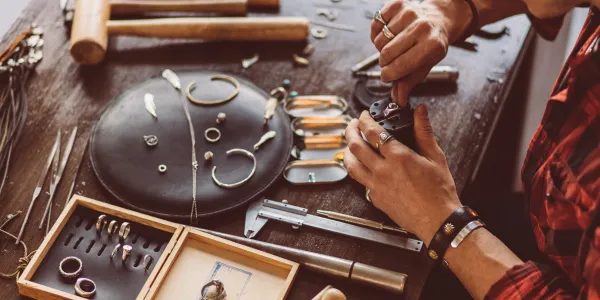
Innovative design, artisan skill, and the use of modern technology
Innovative design, artisan skill, and the use of modern technology are three critical factors that play a significant role in the success of a jewelry manufacturing business.
Innovative design is essential for creating unique and attractive jewelry pieces that stand out in the market. Designers must keep up with the latest trends and styles while also incorporating their unique style and creativity. Creating a distinct design aesthetic can help establish a brand identity and differentiate the business from competitors.
Artisan skill is another critical factor in jewelry manufacturing. Skilled artisans can bring a level of craftsmanship and attention to detail to the production process that sets the business apart from mass-produced jewelry. A highly skilled team of artisans can create intricate designs and bring a sense of artistry to the production process, resulting in high-quality pieces that customers appreciate.
Finally, the use of modern technology can enhance the production process and improve efficiency. The jewelry industry has seen significant advancements in technology in recent years, including the use of 3D printing and computer-aided design (CAD) software. These technologies can help streamline the design and production process, reduce waste, and increase productivity.
Innovative design, artisan skill, and the use of modern technology are critical factors in the success of jewellery business ideas and a jewelry manufacturing business. By focusing on creating unique designs, leveraging the skills of skilled artisans, and utilizing modern technology, businesses can produce high-quality, attractive jewelry pieces that appeal to customers and stand out in the market. In addition, staying up to date with the latest trends and technologies in the industry can help businesses stay competitive and adapt to changes in the market.




